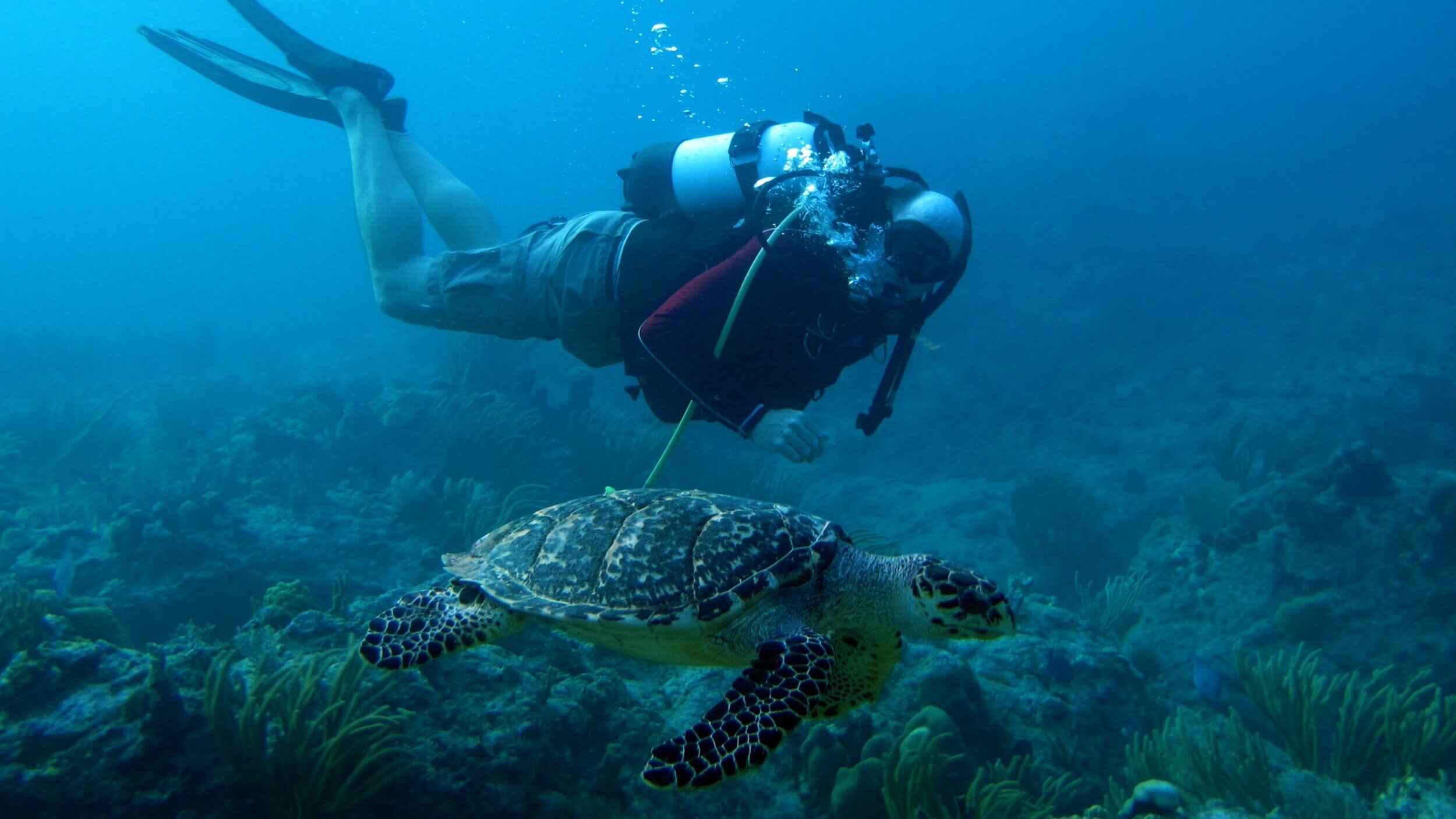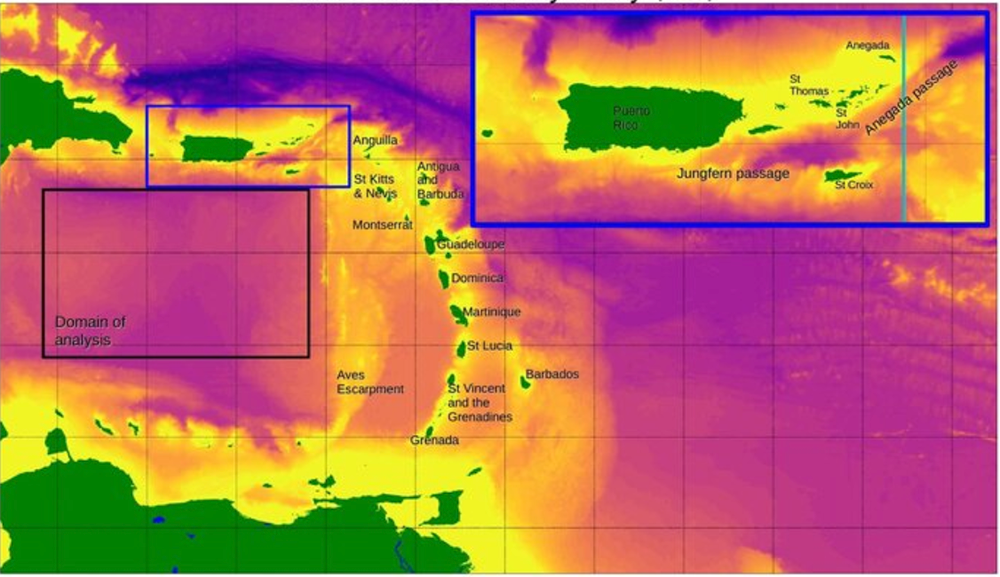EMERGING AREA
Movement Ecology
Section Styles border
Macrofauna movement in a changing marine environment
Charismatic macrofauna are often keystone species for specific marine environments. For example, green sea turtles are the primary grazers of seagrass meadows, and stingrays are major disrupters of the sediment in and around these critical habitats. However, these habitats are changing due to nutrient and sediment runoff carried from the land by increased rain events. Critical seagrass habitats are also being changed by invasive species, such as Halophila stipulacea, from the Red Sea. The nearshore benthic habitat is being changed dramatically as native seagrasses are being lost and H. stipulacea habitat extends much deeper than native seagrasses. The invasion by H. stipulacea affects the foraging and movement behaviors of macrofauna. By studying their movement patterns and changes in the benthic habitat, we are learning more about these interactions and hope to predict how this critical habitat may function in the future.
CONTENT LINKS
Brewers Bay / Project Goals / The VI Sea Turtle Project / Publications / Presentations / Dr. Paul Jobsis / Project Team
Brewers Bay
Brewers Bay, St. Thomas, USVI
Brewers Bay is a well-studied area near the University of the Virgin Islands’ St Thomas campus, where green sea turtles and conch can be monitored in its changing seagrass beds.
Acoustic tracking within Brewers Bay answers key research questions.
With its proximity to UVI’s Center for Marine and Environmental Study, Brewers Bay is an ideal location to facilitate the passive tracking of large vertebrates and invertebrates in a changing seagrass environment. In Brewers our team tracks the movement behavior of mega-grazers, like green turtles and giant hermit crabs over several seasons and we can show that their daily movements are consistent and predictable. We have learned that their movement behaviors are affected by environmental conditions such as temperature and time of day, but also by benthic habitat and the species of seagrass.
A fine-scale acoustic tracking positioning array installed within Brewers Bay allows up to 2-meter accuracy and provides more precise data than any previously available on sea turtle or stingray movement ecology. With this highly accurate positioning, we are answering new research questions, such as, Do keystone species prefer native seagrass habitats? Do changes in environmental conditions change foraging behavior? Do seagrass grazers use the deeper H. stipulacea beds that are well beyond the depth where native seagrasses are found? The increased precision of the new tracking system may answer relevant animal behavior questions on the role of territoriality and how aggressive interactions may play in sea turtle behavior as was hinted at in previous less precise tracking data.
Brewers Bay and Hawksbill Cove are excellent research areas for faculty and students of the University of the Virgin Islands. A fine-scale acoustic array for monitoring animal movement has been installed throughout the area and allows tracking of animals with 2-meter accuracy.
The accessibility to the diverse habitats found in Brewers Bay make it an ideal location for student and faculty research at the University of the Virgin Islands. Stepping off the UVI dock, students are introduced to a complex and changing environment that is home to seagrass meadows, coral reefs, sandy bottom, artificial reefs, and mangroves.
The most common native seagrasses found in the Caribbean grow from the shoreline to depths of 15 to 20 feet. The invasive H. stipulacea replaces many native seagrasses and can grow to depths below 100 feet, dramatically changing the benthic habitat and the forage available to herbivores. Photo here and below: Dan Mele

“I believe in SCIENCE. It is the best way for us to understand our environment and make decisions about its future.”
— Dr. Paul Jobsis
Our short-term and long-term goals
Our Ridge to Reef short-term goals are to install a fine-scale positioning acoustic monitoring array in Brewers Bay and Hawksbill Cove, tag and track macrofauna, like sea turtles, stingrays, and hermit crabs, and monitor how they use this changing habitat. These goals are being accomplished as we have installed a 69 receiver array and tagged over 30 sea turtles and ten hermit crabs. Stingrays will be tagged and tracked in year 4 — all or which requires planning, purchasing, and permitting. As we wrap up this project, we will continue the benthic mapping of seagrass beds to publish how areas are changing. We are building off this grant support by attracting more students and grant + donor support. This will build our team of R2R researchers since we work closely with Drs. Nemeth, Cruz-Rivera, Guannel, and the formal and informal education teams.
Fine-scale positioning acoustic monitoring array is positioned throughout Brewers Bay and Hawksbill Cove
The VI Sea Turtle Project
Hawksbill sea turtles come up on the beaches to lay their eggs. It takes approximately two months to incubate before the nest hatches, and we can tell that a nest has hatched because we will see the tracks of hatchlings crawling towards the waterline.
The VI Sea Turtle Project is monitoring the hawksbill sea turtle populations through their nesting patterns on St. Thomas and St. John. Our goal is to find the beaches that are the most frequented by nesting females and record the amount of nests laid each year. Once a nest had been identified and hatched, we investigate the contents of the nest to see if it successfully hatched, as well as collect genetic samples to learn more about the sea turtle populations in the Caribbean. Sometimes when we dig into an egg chamber, we find hatchlings, such as the ones in the photo, that didn't make it out with the others, so we help to lead them towards the ocean.
Hawksbills are an endangered species and all work is done using permit# DFW19079U. It is illegal to disturb a sea turtle nest.
You can help
Sea turtles can attract many young researchers who are trying to find a career in marine science research and make a positive change in the world. We would appreciate if you could support our work by donating to UVI Sea Turtle Research and Conservation.
Publications
2023 Conference Presentations
“Recently, in the spring of 2023, three of my students, Makayla Kelso, Katie Ayres, and Taylor Brunson, won three of the eight student awards at the International Sea Turtle Symposium. This will always be one of my proudest accomplishments.” - Dr. Paul Jobsis
waves 2- and 3-Dimensional Space Use Show Drivers of Movement, Diving, and Space Use and Suggest Resource Partitioning and Territoriality in Juvenile Caribbean Hawksbill Sea Turtles. Paul Jobsis, Jordan Matley, Lora Johanson*, Natalie Klinard, Jonathan Jossart*, Scott Eanes*. 2023 Gordon Research Conference on Movement Ecology. Lucca Italy.
waves Variations in location by size are evident for hawksbill sea turtles but not green sea turtles in St. Thomas, USVI. Kianna Pattengale*, Sabrina Sorace*, Natalie Monnier*, Kelly Stewart, Paul Jobsis. 2023. 40th Associated Marine Laboratories of the Caribbean meeting. Basseterre, St Kitts.
waves Impacts on Juvenile Eretmochelys imbricata, and Cholonia mydas Body Condition Index in Brewers Bay St Thomas Following Hurricanes and Seagrass Invasion (abstract only). Paul Jobsis, Joseph Townsend*, Kyle Jerris*, Scott Eanes*. 2023, 40th Associated Marine Laboratories of the Caribbean meeting. Basseterre, St Kitts.
waves St. Thomas beaches may be critical male-producing habitat for hawksbills in the United States Virgin Islands. Katie Ayers*, Matthew Godfrey, Kelly Stewart, Paul Jobsis. 2023. 41st International Sea Turtle Symposium. Cartagena, Columbia {Archie Carr Student-Award Winner}
waves Hidden Markov Modelling of Fine-Scale Positioning Acoustic Receiver Array Data in the US Virgin Islands. Kayla Blincow, Taylor Brunson*, Andrew McGregor*, Paul Jobsis. 2023. 41st International Sea Turtle Symposium. Cartagena, Columbia
waves Identifying space use and foraging patterns of juvenile green sea turtles, Chelonia mydas, in a Halophila stipulacea-dominant using a fine-scale positioning acoustic array. Taylor Brunson*, Paul Jobsis, Kayla Blincow, Kristen Hart, Andrew McGregor*. 2023. 41st International Sea Turtle Symposium. Cartagena, Columbia {Archie Carr Student-Award Winner)
waves Investigating Territoriality, Resource Partitioning, and Associated Movement Patterns in Hawksbill Sea Turtles Using Fine Scale Positioning Acoustic Tracking. Andrew McGregor*, Jordan Matley, Paul Jobsis. 2023. 41st International Sea Turtle Symposium. Cartagena, Columbia.
waves Environmental Factors Affect Dive Duration and Space Use in Juvenile Caribbean Hawksbill Sea Turtles (Eretmochelys imbricata). Paul Jobsis, Jordan Matley, Lora Johansen, Scott Eanes, Jonathan Jossart. 2023. 41st International Sea Turtle Symposium. Cartagena, Columbia.
waves Hawksbill Nesting Trends Increased Significantly at Sandy Point National Wildlife Refuge, St. Croix over 30 years. Makayla Kelso, Kelly Stewart, Dante Trivett, Claudia Lombard, Paul Jobsis. 2023. 41st International Sea Turtle Symposium. Cartagena, Columbia. {Archie Carr Award winner}

Section Styles background gallery-block-hover
Dr. Paul Jobsis
Project Lead
As the Center for Marine and Environmental Studies Director I hope to continue our growth and support additional researcher and student opportunities.
VI-EPSCoR has changed my career trajectory and made me a better researcher. My research training in marine mammal diving, cardiac physiology, advanced microscopy, and tissue oxygenation left me well-trained. Still, I needed to be more focused on research that could be done in the USVI. The opportunities provided by VI-EPSCoR have allowed me to focus on movement ecology and seagrass biology. This has allowed me to collaborate with excellent scientists, attract deserving students, train them, and publish in peer-reviewed journals and participate in international conferences.
In the future, I want to direct my research into ecology and conservation by focusing on the changes in sex ratios and basal metabolism in sea turtles affected by climate change. This stems from VI-EPSCoR-supported research showing increased movement and decreased dive duration in critically endangered sea turtles during warm water periods. VI-EPSCoR has also exposed me to a wide range of research, allowing me to pursue interests in Oceanography and Marine Ecology. Using what I have learned as a VI-EPSCoR researcher, I hope to encourage other VI researchers and improve the climate for scientific research in the Territory.
Meet The Team
TEAM MEMBERS – CURRENT AND PAST
Collaborators
Richard Nemeth, Ph.D.
Edwin Cruz Rivera, Ph.D.
Gregory Guannel, Ph.D.
Tyler Smith, Ph.D.
Doug Wilson
Joran MatleyKristen Hart
Kelly Stewart
Larry Wood
Scott Eanes
Students
Corrine Johnson
Taylor Brunson
Katie Ayres
Sabrina Sorace
Natalie MonnierLora Johansen
Kristine Funk
Jessica Michael














